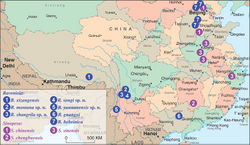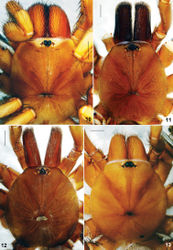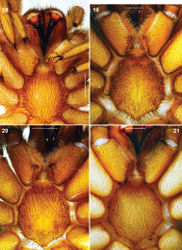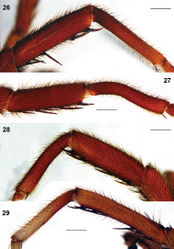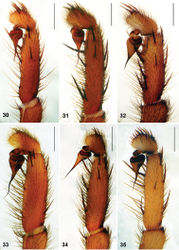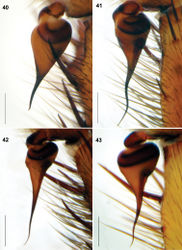Raveniola yunnanensis
| Notice: | This page is derived from the original publication listed below, whose author(s) should always be credited. Further contributors may edit and improve the content of this page and, consequently, need to be credited as well (see page history). Any assessment of factual correctness requires a careful review of the original article as well as of subsequent contributions.
If you are uncertain whether your planned contribution is correct or not, we suggest that you use the associated discussion page instead of editing the page directly. This page should be cited as follows (rationale):
Citation formats to copy and paste
BibTeX: @article{Zonstein2012ZooKeys211, RIS/ Endnote: TY - JOUR Wikipedia/ Citizendium: <ref name="Zonstein2012ZooKeys211">{{Citation See also the citation download page at the journal. |
Genus: Raveniola
Name
Raveniola yunnanensis Zonstein & Marusik sp. n. – Wikispecies link – ZooBank link – Pensoft Profile
Types
Holotype ♂ – CHINA: Yunnan Province, Finchuiyanou Mts. 40 km NNW of Baoshan, 25°28'54"N, 99°05'05"E, 3200 m, 10.05.2005, coll. I. Kabak & I. Belousov (IZAS).
Etymology
The specific epithet is given after the name of the inhabited region (Yunnan).
Diagnosis
Males differ from all other Chinese congeners by lighter body colouration and longer legs (tibia I 5.5 times as longer than wide vs. 4–5 times in other species) and more spinose embolus armed with ca. 25–30 spines (vs. 3–7).
Description
Male (holotype). Body length 12.85. Colour in alcohol: carapace, chelicerae, palps and first pair of legs dorsally intense yellowish orange; eye tubercle with darker spots surrounding AMEs and lateral eyes; sternum, labium, maxillae and legs light yellowish orange; abdomen dorsally uniformly light grey, ventral abdominal surface and spinnerets pale greyish yellow.
Carapace (Fig. 13) 5.73 long, 4.60 wide; covered with moderately dense and thin semi-adpressed dark hairs. Eye diameters (AME, ALE, PLE, PME): 0.17 (0.24), 0.23, 0.13, 0.08/0.09. Interdistances: AME–AME 0.15 (0.10), ALE–AME 0.13 (0.10), ALE–PLE 0.12, PLE–PME 0.05, PME–PME 0.57. Cheliceral furrow with 9–10 promarginal teeth and 6–7 mesobasal denticles. Labium (Fig. 21) 0.43 long, 0.78 wide. Maxillae with 13–16 cuspules in compact area confined to basal maxillary edge. Sternum 2.32 long, 2.34 wide. Palp: 8.29 (3.52, 1.54, 2.41, –, 0.82). Leg I: 18.72 (5.17, 2.86, 4.49, 3.77, 2.43). Leg II: 17.70 (4.84, 2.52, 4.24, 3.67, 2.43). Leg III: 16.52 (4.24, 2.05, 3.52, 4.10, 2.61). Leg IV: 21.57 (5.22, 2.30, 5.02, 6.26, 2.77). Leg I: tibia 5.48 times longer than broad, slightly arcuate, metatarsus slightly curved retroventrally (Fig. 29).
Spination. Palp: femur d1–1–1–1, pd1–1–1; patella p1; tibia d2–1–2, p1–0–1–1–1, pv1–1–2–1, rv1–1–0; cymbium d ca.20. Leg I: femur d1–1–1(0)–0, pd1–1–1; rd 1(0)–1–1; patella p1; tibia p1–1–0, pv1–0–1–1, rv 1–1–0–M–M; metatarsus v0–1–2. Leg II: femur d1–1–1(0)–0; pd1–1–1; tibia p1–1–1, v2(3)–2–3; metatarsus p1–1; v2–2–3. Leg III: femur d1–1–1–1, pd1–1–1, rd1–1–1; patella p1, r1; tibia d1–1–1, p1–1–1, r1–1–1–1, v2–2–3; metatarsus d1–1–1, p1–1–2, r1–1–1–1, v2–2–3. Leg IV: femur d1–1–1–1, pd1–1–1, rd1–1–1; patella p1; tibia d1–1–0, p1–1–1, r1–1–1–1, v2–2–3; metatarsus pd1–1–1, p1–1–1, r1–1–1–1, v2–1–1–3. Tarsi I–IV aspinose.
Scopula: moderately dense and long – entire covering whole ventral metatarsus I and distal 2/3 of metatarsus II, entire on tarsi I–II, divided by setae on tarsus III; widely divided and vestigial on metatarsus III and tarsus IV. Paired claws: legs I–III with 6–8 teeth, leg IV with 9 teeth in two rows on each claw. Trichobothria: 2 rows of 6–8 per row on tibiae, 10–12 on metatarsi, 8–10 on tarsi, 6 on cymbium.
Palpal tibia long; cymbium strongly spinose (Fig. 35). Bulb without ridges; embolus gradually tapering and slightly twisted (Fig. 43).
Spinnerets. PMS: length 0.30; diameter 0.12. PLS: maximum diameter 0.48; length of basal, medial and apical segments 0.83, 0.62, 0.77; total length 2.22; apical segment digitiform.
Female unknown.
Distribution
CHINA: Yunnan Province (Fig. 1).
Taxon Treatment
- Zonstein, S; Marusik, Y; 2012: A review of the genus Raveniola (Araneae, Nemesiidae) in China, with notes on allied genera and description of four new species from Yunnan ZooKeys, 211: 71-99. doi
Images
|
